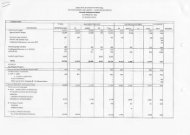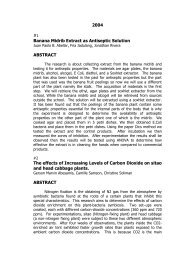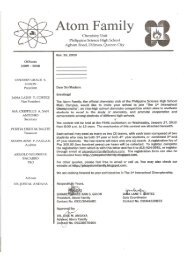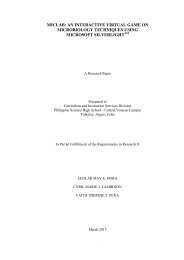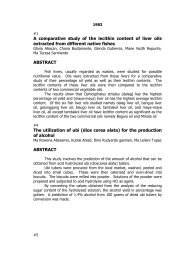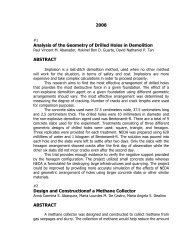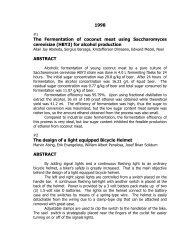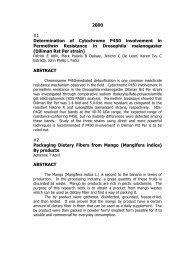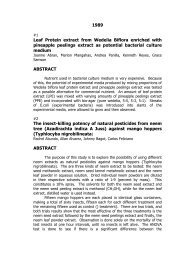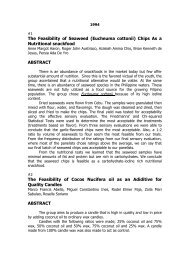(LATO) IN LOWERED SEAWATER pH - Central Visayas Campus ...
(LATO) IN LOWERED SEAWATER pH - Central Visayas Campus ...
(LATO) IN LOWERED SEAWATER pH - Central Visayas Campus ...
You also want an ePaper? Increase the reach of your titles
YUMPU automatically turns print PDFs into web optimized ePapers that Google loves.
Ilustrisimo, C. A., I. C. Palmitos, R. D. Señagan. 2013. “Growth Performance of<br />
Caulerpa lentillifera in Lowered Seawater <strong>pH</strong>”. A Research Paper. Philippine Science<br />
High School – <strong>Central</strong> <strong>Visayas</strong> <strong>Campus</strong>, Talaytay, Argao, Cebu.<br />
ABSTRACT<br />
Ocean acidification, as a result of increased atmospheric carbon dioxide (CO2)<br />
concentrations, is predicted to lower the <strong>pH</strong> of seawater over the next 100 years<br />
(Clark et al. 2009). The aim of the study was to determine the growth performed by<br />
Caulerpa lentillifera as the test species in lowered seawater <strong>pH</strong>. To verify the growth<br />
performance of the species, an acidic environment was made with a range of lower<br />
seawater <strong>pH</strong> (<strong>pH</strong> 2.7 -3.3, 3.7-4.3, 5.7-6.3 and 7.7 to 8.3). Acidity was adjusted by<br />
adding a reagent grade of hydrochloric (HCl) acid. Species treated with <strong>pH</strong> 7.7 to 8.3<br />
were held as the controlled group. Experimental conditions (temperature, salinity,<br />
dissolved oxygen, and <strong>pH</strong>) were observed daily as accounted by Battistoni et al.<br />
(2007). Different physical changes (weight and color) were also observed. The<br />
amount of chlorophyll a content of the seaweed after the treatment was examined by<br />
reading its absorbance at 645 nm and 662 nm using UV-Vis spectrophotometer.<br />
Lowering <strong>pH</strong> resulted in a decrease in survival of the species. Species treated in <strong>pH</strong><br />
7.7 to 8.3 contains 11.92 mg/L chlorophyll a and was the highest amount of<br />
chlorophyll a content, followed by <strong>pH</strong> 5.7 to 6.3 which was 11.66 mg/L, <strong>pH</strong> 2.7 to 3.3<br />
which was 0.1551 mg/L and lastly, <strong>pH</strong> 3.7 to 4.3 containing 0.1198 mg/L. The<br />
statistical results proved that there was a significant difference on the weights of the<br />
samples in the three trials among the four groups. The study concluded that lowering<br />
seawater <strong>pH</strong> (ocean acidification) will result to a decrease in weight and chlorophyll a<br />
content of C. lentillifera, implying a negative effect on the growth of the species.<br />
vi



